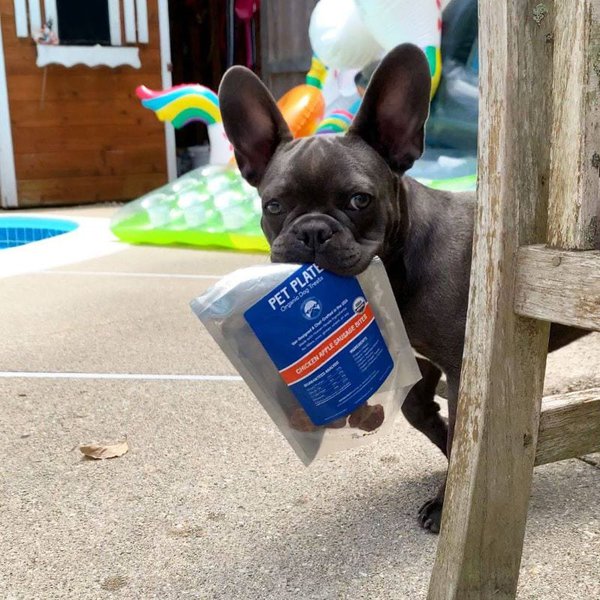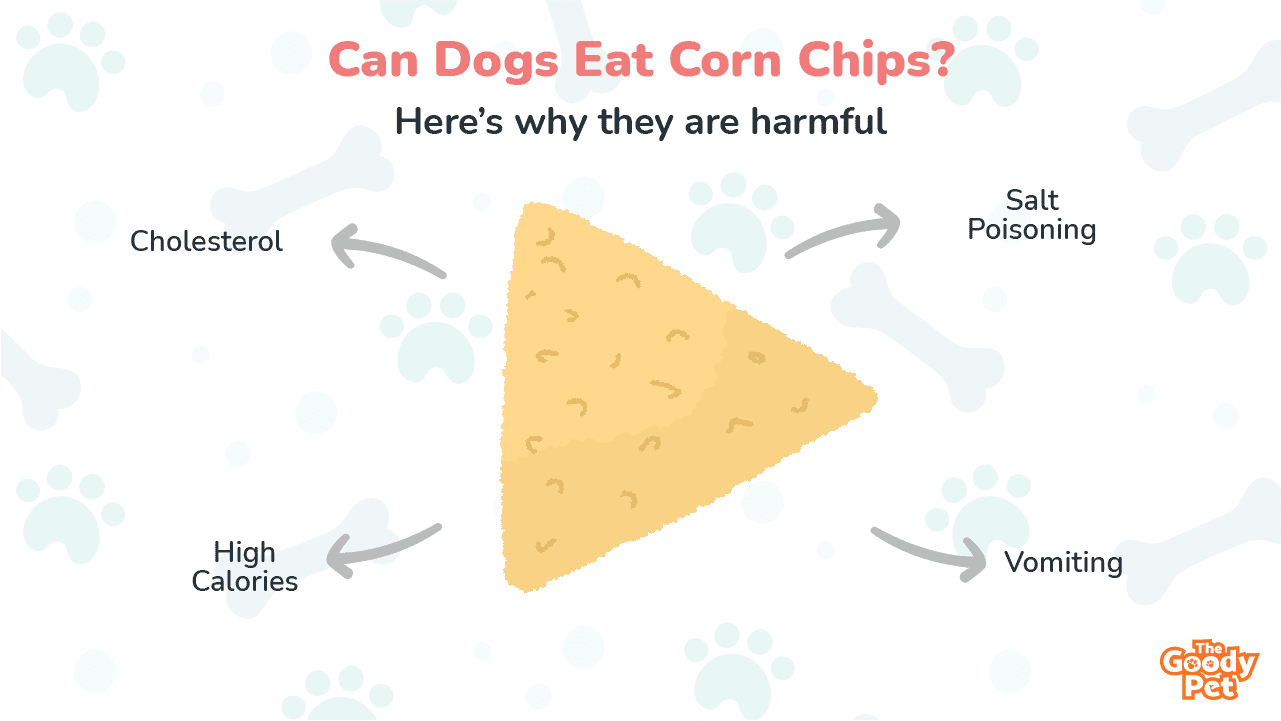It’s easy to think that dogs can eat corn chips. After all, isn’t corn a universally accepted food eaten and enjoyed by many? Add that to the many dogs you’ve seen wolfing down corn grains with a happy tail-wag, and it should be a no-brainer that dogs can eat corn chips, right?
The answer is no. Although dogs can eat a meal of corn grains, processed products like corn chips could hurt your pooch because it contains salt and additional substances that could upset a dog’s digestive system, cause coma or possibly death.
It’s also important to note that corn chips or Fritos are different from tortilla chips or Doritos and, as such, your canine companion would react differently if it ate them. If you’re someone who likes to savor the sumptuousness of a meal together with your pet, then you would want to be careful of the kind of food your pooch can eat.
In this article, you’ll find out why corn chips are harmful to dogs, what happens when a dog eats corn chips, what salt poisoning is, symptoms of salt poisoning, how to identify symptoms of salt toxicity, and whether or not a dog can eat Fritos.
Are Corn Chips Safe For Dogs?

Corn chips are bad for dogs because they are categorized as processed food with a high sodium content that could lead to salt poisoning.
In other words, aside from the harmful effects of salt present in corn chips, the compounds and seasonings used in its preparation and preservation could shorten your doggie’s lifespan.
It’s imperative to note that salt poisoning is the most lethal yet unknown to dog owners of all the harmful effects a dog could experience from eating corn chips.
Hence, we’ll briefly explain salt poisoning, as well as the other dangers of feeding corn chips to your dear Fido.
Cholesterol
You’ve heard of how too much cholesterol is bad for humans. Well, the same applies to dogs too. Corn chips pass through a deep frying process and soak up lots of oil while the process is ongoing. Furthermore, the chips are coated with other oily compounds to keep them crispy after frying.
The cholesterol in corn chips could build up in your four-legged companion’s body, clogging its arteries and blocking the supply of blood to its heart, which could lead to death.
High Calories
Most junk foods have high-calorie content that could quickly store up in your furry buddy’s body and cause increased weight gain. Remember that many dog breeds are obesity-prone, and a meal of corn chips packed with so many calories can cause an uncontrollable ballooning in a short time.
Allergic Reactions
The flavorings used in adding taste to corn chips, such as onions and garlic, can cause allergic reactions. And dogs are like humans in this respect because you can never tell that your pooch has an allergy until you give it corn chips to eat. Therefore, the best way to prevent any unpleasant episodes is to feed dogs with generally proven dog food.
Salt Poisoning
Salt poisoning in dogs occurs due to excess salt intake, which affects the functionality of cells in a dog’s body. A little refreshing of our high school biology would help us better understand the salt poisoning phenomenon and why it’s so dangerous to your pooch.
Why Is Salt Poisoning Dangerous to Dogs?
Excess salt in a dog’s body disrupts all the normal cell functions, interrupting brain function and muscle coordination.
As you know, cells are the life force of all living things, and inside every cell is a liquid called the cytoplasm where most cellular activities occur. Molecules move in and out of the cytoplasm through a process called osmosis.
Salt, also known as sodium chloride, moves through the cytoplasm, aiding the many cellular activities in the cells. However, when a dog ingests too much sodium – sodium being the main culprit in the equation – the excess salt finds its way into the cells and starts to damage functionality there.
In response to the upsurge of sodium, the cytoplasm forces the excess salt out of the cell, albeit with other beneficial molecules, in the form of liquid, shrinking the cell and reducing its vitality in the process.
The resultant effect is total body constriction which manifests in body spasms, brain swellings, etc.
What Happens If You Give A Dog Chips?

Feeding a handful of corn chips that your dog can nibble on, although not advisable, would not harm your pooch. However, a standard full-bowl meal of corn chips fed to any dog would hurt it considerably.
Can a Dog Survive Salt Poisoning?
Naturally, when a dog ingests too much salt, its survival instincts kick in and drive it to drink more water which balances out the high salinity in its bloodstream.
However, suppose your dear Fido doesn’t get enough water to drink or drinks salty water instead of freshwater, the excess salt would damage its cells and cause the occurrence of life-threatening symptoms.
Survival after sodium consumption depends on the amount of salt ingested and the quickness of treatment received after ingestion. Therefore, a keen observation of your four-legged companion’s behavior could mean all the difference between life and death.
Symptoms of Salt Poisoning in Dogs
There are specific indicators to know when a dog is suffering from salt toxicity. Below are some telltale signs to watch out for:
Extreme Thirst
The first mild sign of salt toxicity in a dog is overwhelming thirst. Should your canine companion eat or drink something high in sodium, its throat would dry up within hours, and an irresistible craving for water would kick in.
A dog lapping up water like its life depends on it without having exercised could be exhibiting the first stage of salt poisoning.
Coma
Coma from excess sodium in your furry buddy could come about due to ruptured cells during shrinking. The bleeding cells in the brain hamper functionality, forcing the pup’s brain to shut down and enter a comatose state.
Seizures
Seizures occur when a dog’s brain swells and causes the misfiring of neurons which in turn send erratic, meaningless impulses through a dog’s body. Brain swelling occurs when a dog, having consumed too much salt and consequently suffering from the throat-drying effects of dehydration, drinks too much water.
The overconsumption of water floods the already shrunken cells with more than enough liquid and causes an over-absorption that leads to excessive swelling. Generally, seizures manifest as repeated epileptic episodes and loss of muscle coordination.
Muscle Spasms
The shrinking of cells in the muscles causes them to contract and become extremely difficult to move. So if your furry buddy starts to experience sudden partial muscle paralysis, then chances are that it might have swallowed something highly concentrated in sodium.
Vomiting
The abdominal pain and stomach upset from eating a heavily salted meal will induce vomiting in your dear Fido. If you discover your pet is vomiting while still manifesting other symptoms listed here, that could be a high possibility of high sodium intake.
Other evident symptoms of salt poisoning in dogs are:
- Headache
- Swollen Tongue
- Diarrhea
- Lethargy
- Fever
- Palpitations
Can A Dog Eat Fritos?
No, a dog should not be eating Fritos. Feeding Fritos to your dog is a sure recipe for health-related diseases.
For one, the process of making Fritos involves deep frying in oil that could upset your furry buddy’s digestive process. Also, keep in mind that these oils aren’t altogether healthy, and consuming such is an all-out invitation to obesity for any dog.
Should You Give Your Dog Fritos as an Occasional Treat?
Treating your dog to Fritos from time to time is an unhealthy and risky habit. Fritos is classified under junk food, and you’re well aware that junks are addictive. Reinforcing your pooch’s positive habits by deliberately getting it hooked on obesity-inducing food is not only a bad practice but also tells badly on you as a caring dog owner.
Several other healthy treats such as cashew nuts, boiled eggs, fish, etc., abound that you could feed your dog with.






